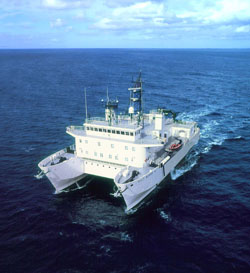Ocean Research Fleet Will Be Adrift Without New Technologies
Bandwidth demands and the increased use of autonomous aerial and underwater vehicles are among the challenges for the nation’s aging fleet of ocean research ships. A report from the National Research Council’s Ocean Studies Board predicts that the fleet will face even more demands on its time in the future. “The pace of technological advances in oceanography continues to accelerate,” the report’s authors state, requiring a comprehensive, long-term plan for replacing current vessels and accommodating new technologies.
The Office of Naval Research and the National Science Foundation asked the board to assess how rapid advances in ocean-observing technology will affect the ocean research fleet. The board’s Committee on Evolution of the National Oceanographic Research Fleet concluded that the fleet needs bigger ships to accommodate more missions and equipment, more bandwidth to access satellite remote sensing data and for ship-to-shore communications, dynamic positioning on ocean-going vessels, and designs that enable more use of autonomous vehicles and remotely operated vehicles.
 |
The R/V Kilo Moana is a general-purpose oceanographic research ship designed to operate in coastal and blue water areas. Owned by the U.S. Navy, it is operated by the University of Hawaii Marine Center. |
The scientific user community needs to be involved in ship design from the preconstruction phase onward, the report’s authors note. Research ships can have a life span of 30 or more years, so their designs must be able to adapt to new capabilities.
Technologies considered essential in scientific research today—the Global Positioning System, autonomous vehicles, the Internet, satellite communications—did not exist or were new when many of the ships in the current fleet were built, the report’s authors point out. This requires costly and sometimes inefficient retrofits. Instruments and antennas vie for space on ships, which often compromises their performance.
The committee notes that ships in the research fleet already are supporting the simultaneous operation of multiple autonomous vehicles. Increased ship-to-shore bandwidth would enable more real-time participation in ships’ research by land-based researchers. The fleet also will need both highly adaptable general-purpose ships and specialized vessels.
The fleet is managed by the University-National Oceanographic Laboratory System (UNOLS), a consortium of research institutions, federal agencies, and state and private organizations. UNOLS coordinates 22 vessels for 61 institutions. The U.S. Navy owns six of those vessels. The report’s authors conclude that this management structure is sound.


Comments